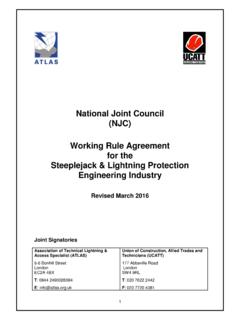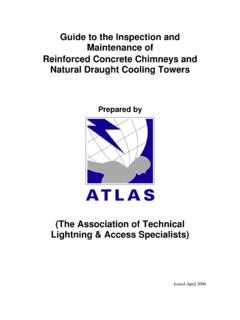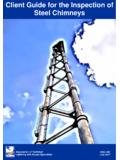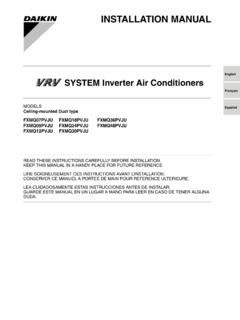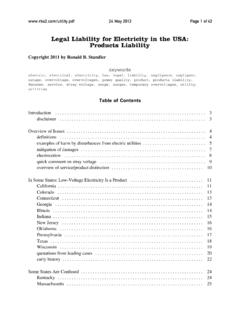Transcription of (ASSOCIATION OF TECHNICAL LIGHTNING & …
1 Guide to the Inspection of Single Flue Industrial Steel Chimneys Prepared by ( association OF TECHNICAL LIGHTNING & access specialists ) FORWARD The Health and Safety Executive welcome this guide prepared by the association of TECHNICAL LIGHTNING & access specialists that builds on the existing HSE document GS53. This guidance document provides good advice on the inspection of single flue chimneys. Of note is the need for those who commission chimney inspections to ensure that those undertaking the inspections are competent and that they are provided with adequate information on the chimneys design, construction and the nature of any flue deposits.
2 Additionally the guide highlights the important role of designers to ensure that the designs of new chimneys address the need for safe erection and subsequent maintenance. Construction Division Health and Safety Executive February 2004 TECHNICAL GLOSSARY Cyclic loads: Loads which occur at regular intervals. To affect a chimney they must last long enough to set up vibrations in the chimney. They may be superimposed on steady-state loads, gusts in a windstorm. Natural frequency: The frequency at which a chimney will resonate.
3 Each chimney has an indefinite number of natural frequencies, set by its cross section. At resonance, the chimney will vibrate with large amplitudes. Chimney shell: The actual body of the chimney which incorporates the exhaust flue and provides the load bearing capacity. Abrasion: A type of attack brought about by grit particles travelling in a fast moving exhaust gas stream, it is a mechanical process. Condensate: The liquid by-product of a hot gas cooling. Acid dew-point: The temperature at which a hot acid gas returns to liquid phase.
4 Service life: The nominated life expectancy of a chimney when it was designed. Downdraft: The cooler, less buoyant, exhaust gases that fall into the region around the top of the chimney. Non-destructive test: A method of testing the chimney to discover surface and sub-surface defects without damaging the fabric of the chimney. INTRODUCTION 1 In 1992, the Health and Safety Executive ( ) carried out a national survey to find out about the condition of single-flue steel chimneys (See Appendix A). This highlighted that there was a lack of information relating to their inspection and maintenance.
5 As a direct result of the survey the produced a guidance note (Ref. GS53) to review the necessity for, and methods of, carrying out inspections of single-flue steel industrial chimneys. 2 This booklet is designed to further expand upon the points raised by the and provide a source of reference to those responsible for the upkeep of structures of this nature. This will include chimney owners, chimney inspection contractors and consulting engineers. 3 Owners, operators and users of steel industrial chimneys have a duty to protect the health and safety of their employees and others affected by the operation of the chimney.
6 To satisfy this requirement it is imperative that the chimney is maintained in a satisfactory condition. THE HAZARD Frailty of single-flue steel chimneys 4 Single-flue steel chimneys rely on the structural integrity of the flue for their stability. They are vulnerable structures because the flues vent agents, which cause rapid deterioration of steel (See Appendix B). In addition, they are dynamically sensitive and complex structures. They are different from conventional structures because they respond to cyclic components of everyday loads, especially wind.
7 If the frequency of the cyclic component is within 10% of one of the chimney s own natural frequencies, this response is magnified, sometimes with catastrophic results. 5 This susceptibility to cyclic loading means that the design of a chimney is a specialist process. It requires the provision of sufficient material to ensure structural integrity, which needs to be balanced by the material requirements for desirable dynamic behaviour. If a chimney is to behave in the way that the designer wants it to, its shell thickness must be maintained above a specific minimum.
8 Appearances may deceive 6 Current insulation methods, which use corrosion resistant casings, cover the flue and give a false impression of its condition. Quite often, the shiny exterior of the casing for the insulation can hide a badly corroded shell. While current design requirements ensure that steel chimneys have an inherent factor of safety, some have collapsed and there is plenty of evidence of just-in-time repairs. Consequences of a collapse 7 The consequences of a chimney collapse could be very serious because the potential drop-zone may cover a large area and could put people and hazardous processes at risk.
9 CAUSES OF DETERIORATION IN STEEL CHIMNEYS Lack of inspection and maintenance 8 The susceptibility to deterioration of many items of plant is well known. Consequently, they are subject to regular maintenance/repair programmes. However, in the majority of cases, steel chimneys are treated differently because it is not widely appreciated how much wear and tear they are actually subject to. This failure to recognise the potential for deterioration has led to a significant number of steel chimneys not being included in planned preventive maintenance programmes.
10 9 In recent years, other developments have contributed to the deterioration of steel chimneys by making proper inspections difficult. For instance, aluminium sheeting encasing mineral wool has become a common form of insulation used for steel chimneys, but it allows only limited access for inspection of the load bearing steel work. Consequently, advanced corrosion can take hold before it is noticed. In addition, the appearance of the aluminium cladding can be misleading, giving the impression that all is right with the chimney.


